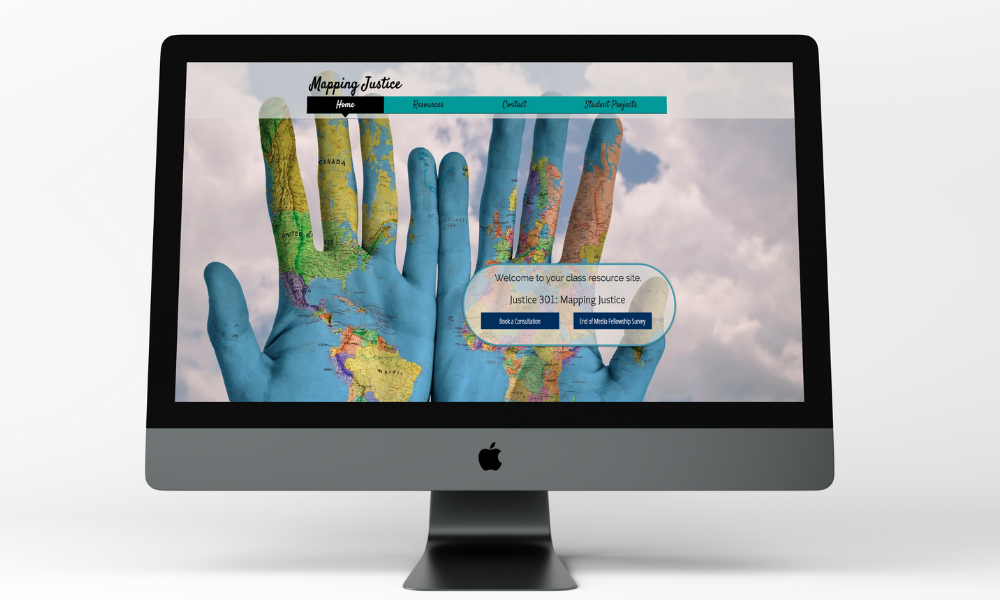DigiComm’s Mapping Justice Media Fellowship, Spring 2018
News
SUMMARY: Read more about how media fellow Teresa Cummings aided Professor Watkins and his JUST 301 students in the process of mapping justice across the world.
“Mapping Justice”
The word “justice” conjures up different images for each of us, depending on our cultural or family backgrounds, and perhaps on our personal experiences with injustice. As part of his Justice Studies 301 course, aptly titled “Mapping Justice,” Dr. Case Watkins had his students create interactive maps in Esri, a geospatial mapping platform. Their assignment was to tell the story of justice in situations around the world, ranging from the definition of justice in capital punishment in the U.S. to the interaction between justice and the law in civil wars within different South American countries.
Put mildly, mapping justice was no simple task for Dr. Watkins and his students. Over the course of the semester, students learned to represented government data visually by using content creation tools to build their own infographics and media, and then combined those elements with a narrative they had written. The students also created their own interactive maps using satellite images from ArcGIS and other tools within Esri, a geospatial mapping platform. For their final project, the class sewed all of their maps, media, and narratives together in a separate platform called Esri Storymaps.
Dr. Watkins initially offered the course without DigiComm support during the fall 2017 semester. “At that point,” he shared, “I was unaware that Media Fellows were working with online maps using ESRI products.” Given his positive experiences with DigiComm in the past, and the multifaceted and complex nature of this particular course, he shared “I had benefited from presentations by DigiComm consultants in a few other classes and jumped at the chance of having a dedicated Media Fellow for Mapping Justice.” In the spring of 2018, Dr. Watkins welcomed Media Fellow Teresa Cummings to his class, where she collaborated with him in identifying areas in which students needed additional support as they began “mapping justice.”
The Role of the Media Fellow
Teresa described her media fellow role as that of a “bridge” connecting the students, the professor, and the content. “The media fellow provides students with some ‘how to’ help on different platforms and a listening ear,” she explained, “and then, with information gained from that listening ear, the media fellow has the ability to go to the professor and say ‘Hey, I noticed some confusion here.’” Dr. Watkins supported this idea of the media fellow as a bridge by which professors can better understand their students’ needs, and modify their course materials accordingly. He shared that having a DigiComm media fellow in his class “afforded me a fresh set of eyes on course content, helped me develop and organize digital resources that have remained useful in subsequent offerings, and connects the course with the DigiComm office and its services, such as one-on-one consulting with DigiComm Tutors.”
In addition to opening up a more direct dialogue between the students and the professor, Teresa created a website to provide additional support. The website contained various resources, some from DigiComm, and some created specifically for the clas (i.e. youtube videos on creating and embedding maps and infographics). Dr. Watkins asserted that these customized materials, combined with Teresa’s willingness to fully immerse herself in the platforms, made her a valuable and knowledgeable resource in his classroom. “Teresa went above and beyond,” he wrote, “by learning the software in detail so that she could develop the tutorials and other resources and later conduct one-on-one consultations with students in my course and others using ESRI products.”
Student Outcomes
Although media fellows are intended as a support for faculty, DigiComm also strives to empower individuals to be content creators. As a media fellow, Teresa assisted Dr. Watkins in helping students feel more secure in their ability to create exciting new digital content. “I think the students definitely thought it was valuable,” Teresa shared, continuing to say “I’ve talked with a few of them, and they’ve gotten internships because of the work they did in this class...Learning these new platforms, especially for students who aren’t in geospatial information systems, that’s a big deal.” Teresa also noted that in tackling such massive projects as “Mapping Justice,” not knowing, can be just as important as knowing. “Everyone’s a walking question mark,” she jokes, “and that’s good, because that means you’re questioning. That means you’re looking for an answer.”
Looking Forward
Overall, it is no secret that the future of storytelling and research is becoming increasingly digital. Therefore, DigiComm’s efforts in helping professors incorporate digital tools into their students’ coursework has the potential to transform the way both students and teachers communicate information. Digital storytelling allows students to transform their traditional coursework into more versatile and accessible formats that can be appreciated by a wider audience. Commenting on the value of having digital communication in the classroom, Dr. Watkins noted that “When combined with solid academic fundamentals, digital communication allows students to reinforce and showcase their arguments in innovative and exciting ways.” Teresa corroborated this point with an example: “Instead of having to hand in a 100 page paper on why social justice is important, students can give a short link and say ‘Hey, click through this! This is amazing. This is what I’ve done.’”
